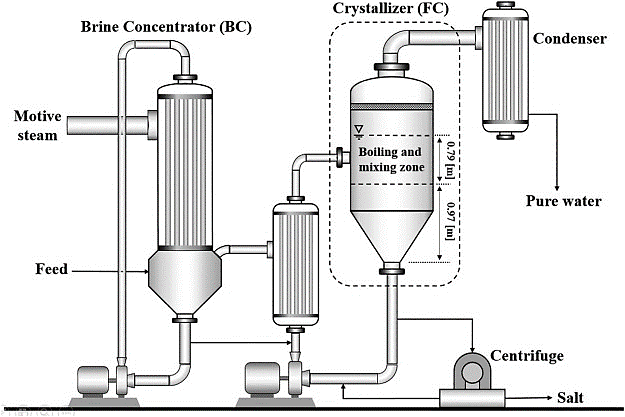
Crystallization is a physical change. Crystallization is the formation of solids from the liquid or gaseous phase. This technique includes obtaining the crystals of a soluble substance from a hot saturated solution and separating the soluble solid from the solution.
To concentrate feed into solid crystals and clean water, crystallizers are used. A progressively harder method for which crystallite sizes are formed from a liquid solution is known as crystallization. Crystallizers can remove liquid wastes completely, resulting in no liquid discharge (ZLD). The process continues and secondary crystallization are the two stages of crystallization. The formation of new crystals is referred to as primary nucleation. Secondary nucleation is the primary stage that results in the mass production of crystals. There are two types of crystallization processes: evaporative crystallization and cooling crystallization.
Aspect papers signify probably the most Highly developed exploration with substantial probable for high effect in the sphere. A Function
: Zero liquid discharge (ZLD) is a method for treating high-salinity brine to acquire freshwater and/or salt utilizing a solar interface evaporator. Having said that, salt accumulation on the floor in the evaporator is an enormous challenge to sustaining secure drinking water evaporation. On this research, a straightforward and simple-to-manufacture evaporator, also called a crystallizer, was designed and fabricated by 3D printing. The photothermal layer printed with polylactic acid/carbon composites had appropriate gentle absorption (ninety three%) in the wavelength zone of 250 nm–2500 nm. The micron-sized voids formed all through 3D printing furnished plentiful h2o transportation channels inside the crystallizer.
Concentrating and crystallizing useful enter resources Utilized in the creation of every day items,
a The water evaporation charge of your solar crystallizer working with concentrated SWRO brine with eight.four‰ NTA; b Image image from the solar crystallizer and gathered salt following 24-h operation; c Image picture with the solar crystallizer soon after eradicating gathered salt soon after 24-hour operation; SEM illustrations or photos of d QGF membrane after 24-h operation and e the salt crystals collected in the outer area; f Photograph graphic of the solar crystallizer and self-defoliated salt right after forty eight-h operation (the purple dotted body represents the placement of taken out solar crystallizer); g the water evaporation charge with the solar crystallizer through the 288-h operation (each issue over the curve was the normal evaporation fee of 24 h).
3d. It Obviously shows the internal side from the QGF membrane was fairly clean up with negligible salt crystals observed. The clean up inner aspect and the thick salt crust layer about the outer floor could be described as follows.
It wicks brine from your supply brine reservoir and enables the brine to distribute about the whole outer area through Procedure. The interior layer in the 3D crystallizer functions as The sunshine absorbing surface though the outer QGF membrane serves as water transportation and evaporation area. The aluminum sheet entirely separates the two Energetic surfaces and has a desirably higher thermal conductivity (~200 W m−1 K−one), which is useful for the heat conduction. The solar crystallizer is directly placed on best of an expanded polystyrene foam by using a minimal thermal conductivity (
Right disposal of industrial brine is a significant environmental challenge. Zero liquid discharge (ZLD) brine cure retains excellent assure to the brine disposal, but its application is proscribed from the intensive Electrical power consumption of its crystallization approach. In this article we propose a fresh system that employs an advanced solar crystallizer coupled that has a salt crystallization inhibitor to do away with really concentrated waste brine. The rationally built solar crystallizer exhibited a large h2o evaporation rate of 2.
What's more, as being the evaporation charge was decaying with time, the temperature of the crystallizer step by step greater (Fig. 3f) like a way of releasing more heat in the setting so to succeed in a whole new equilibrium With all the secure and unaffected solar influx.
The collapse of your bubble offers ample Vitality to speed up the nucleation system. This makes crystallizations that are quite reproducible and predictable, as Crystallizer Manufacturer Crystallizer For Zero Liquid Discharge System well as a number of other pros.
Batch vacuum crystallizers are useful for the distillation method. Distilled material grows to the crystallization machine in ongoing crystallization walls. Vacuum crystals are accustomed to retail store vacuum Within the crystallizer body with the help of the condenser booster.
Contact us with the chemistry for an evaluation. Learn if ChilledCrys can offer your project Along with the step modify in ZLD prices that a lot of are in search of.
Furthermore, the scalability of solar crystallizer can be a critically critical thought. The solar crystallizer could be simply scaled up by enlarging its measurement along with the brine treatment method ability of such a system may be multiplied by applying an assortment of the photo voltaic crystallizers. A number of enlarged gadgets with varying magnification ratios were fabricated. Their similar evaporation fees verify the dimensions magnification will not impact the overall performance considerably when they are utilized as a single device. Then twelve solar crystallizers ended up assembled to type an array and the array was challenged to take care of the very concentrated real SWRO brine of 21.
By style, our 3D solar crystallizer fully bodily separates its light-weight absorbing surface and water evaporation and thus salt precipitation surface area, which solves The downside of precipitating salt crystals impacting gentle absorption if not inherent in 2D gadgets and allows for two surfaces for being independently optimized.
As a result, the NaCl salt crust has a tendency to growth along the out-of-aircraft course to steadily enhance its thickness and to take care of its porosity relatively consistent. The porosity of your salt crust formed by pure NaCl brine (20 wt%) is 19.3% depending on mercury intrusion porosimetry measurement. As illustrated in Fig. 5a, the loosely packed pure NaCl salt crust layer permits liquid drinking water and h2o vapor transportation, which explains the stable h2o evaporation functionality with pure NaCl brine.